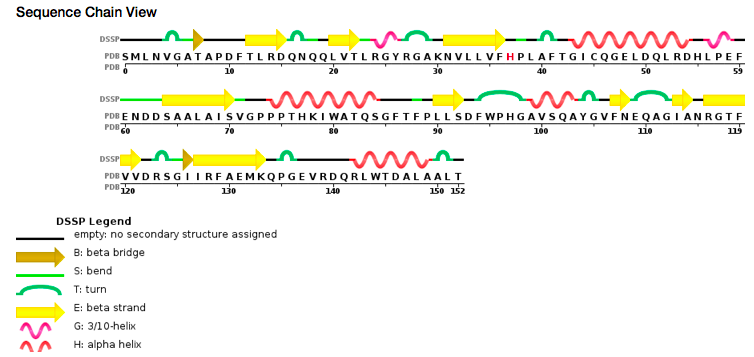Sandbox Reserved 1508
From Proteopedia
| Line 9: | Line 9: | ||
Peroxiredoxins are peroxidases which catalyze the reduction of peroxides (organic peroxide H2O2 or organic hydroperoxides). | Peroxiredoxins are peroxidases which catalyze the reduction of peroxides (organic peroxide H2O2 or organic hydroperoxides). | ||
| - | |||
== Biological function == | == Biological function == | ||
| Line 50: | Line 49: | ||
According to researches on biosynthetic pathway in ''Mycobacterium tuberculosis'' (Burns et al, 2008), there are three pathways implicated cysteine in this disease: the sulfide dependent pathway, the cystathionine pathway and the CysO-thiocarboxylate pathway. For the CysO depending pathway, transcriptional profile analysis shown that cysM and cysO are upregulated under oxidative stress conditions. Moreover, the thiocarboxylate are much more resistant to oxidation than thiols. Thus, when the disease occurs, the environment becomes highly oxidizing due to the macrophages, leads to the cysteine biosynthesis. The CysO-thiocarboxylate evolves as an oxidation resistant form of sulfide, thiol is favored for the cysteine biosynthesis. | According to researches on biosynthetic pathway in ''Mycobacterium tuberculosis'' (Burns et al, 2008), there are three pathways implicated cysteine in this disease: the sulfide dependent pathway, the cystathionine pathway and the CysO-thiocarboxylate pathway. For the CysO depending pathway, transcriptional profile analysis shown that cysM and cysO are upregulated under oxidative stress conditions. Moreover, the thiocarboxylate are much more resistant to oxidation than thiols. Thus, when the disease occurs, the environment becomes highly oxidizing due to the macrophages, leads to the cysteine biosynthesis. The CysO-thiocarboxylate evolves as an oxidation resistant form of sulfide, thiol is favored for the cysteine biosynthesis. | ||
| - | |||
</StructureSection> | </StructureSection> | ||
== References == | == References == | ||
Revision as of 14:49, 11 January 2019
| This Sandbox is Reserved from 06/12/2018, through 30/06/2019 for use in the course "Structural Biology" taught by Bruno Kieffer at the University of Strasbourg, ESBS. This reservation includes Sandbox Reserved 1480 through Sandbox Reserved 1543. |
To get started:
More help: Help:Editing |
The protein 5C04
| |||||||||||
References
Ågren, Daniel, Robert Schnell, Wulf Oehlmann, Mahavir Singh, et Gunter Schneider. « Cysteine Synthase (CysM) of Mycobacterium Tuberculosis Is an O -Phosphoserine Sulfhydrylase: EVIDENCE FOR AN ALTERNATIVE CYSTEINE BIOSYNTHESIS PATHWAY IN MYCOBACTERIA ». Journal of Biological Chemistry 283, nᵒ 46 (14 novembre 2008): 31567‑74. https://doi.org/10.1074/jbc.M804877200.
Burns, Kristin E., Sabine Baumgart, Pieter C. Dorrestein, Huili Zhai, Fred W. McLafferty, et Tadhg P. Begley. « Reconstitution of a New Cysteine Biosynthetic Pathway in Mycobacterium t Uberculosis ». Journal of the American Chemical Society 127, nᵒ 33 (août 2005): 11602‑3. https://doi.org/10.1021/ja053476x.
Pedre, Brandán, Laura A. H. van Bergen, Anna Palló, Leonardo A. Rosado, Veronica Tamu Dufe, Inge Van Molle, Khadija Wahni, et al. « The Active Site Architecture in Peroxiredoxins: A Case Study on Mycobacterium Tuberculosis AhpE ». Chemical Communications 52, nᵒ 67 (2016): 10293‑96. https://doi.org/10.1039/C6CC02645A.
Rhee, Sue Goo, et Hyun Ae Woo. « Multiple Functions of Peroxiredoxins: Peroxidases, Sensors and Regulators of the Intracellular Messenger H 2 O 2 , and Protein Chaperones ». Antioxidants & Redox Signaling 15, nᵒ 3 (août 2011): 781‑94. https://doi.org/10.1089/ars.2010.3393.
Zeida, Ari, Aníbal M. Reyes, Pablo Lichtig, Martín Hugo, Diego S. Vazquez, Javier Santos, F. Luis González Flecha, Rafael Radi, Dario A. Estrin, et Madia Trujillo. « Molecular Basis of Hydroperoxide Specificity in Peroxiredoxins: The Case of AhpE from Mycobacterium Tuberculosis ». Biochemistry 54, nᵒ 49 (15 décembre 2015): 7237‑47. https://doi.org/10.1021/acs.biochem.5b00758.



